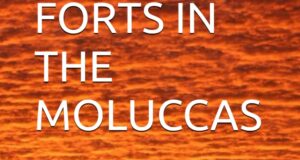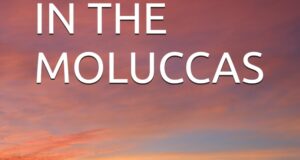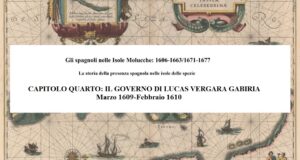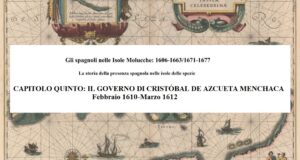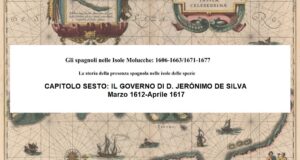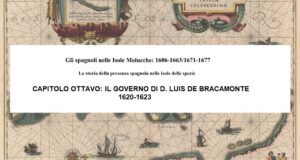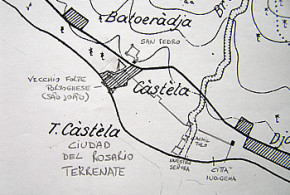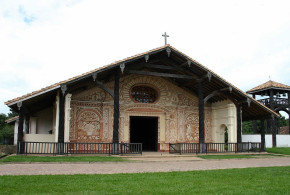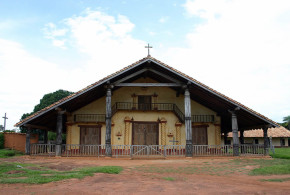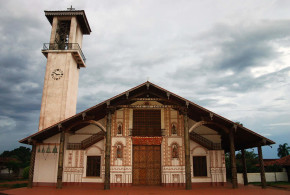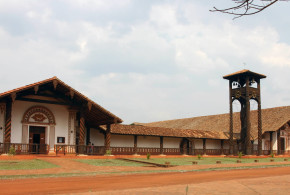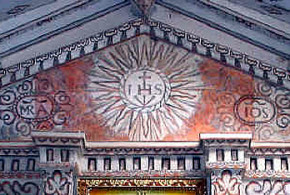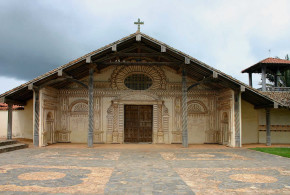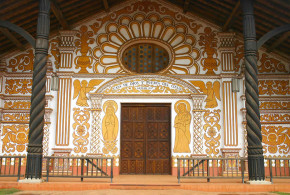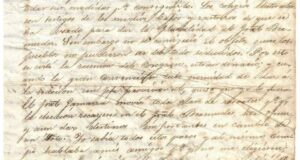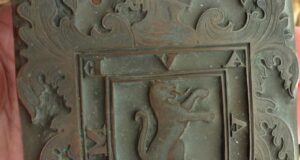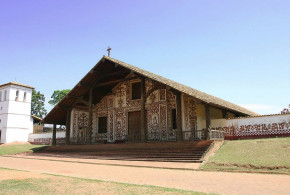This post is also available in:
![]() Italiano
Italiano
Written by Marco Ramerini – 2000-2007/2023
3 – THE SPANISH EXPEDITIONS TO THE MOLUCCAS AFTER THE UNION WITH PORTUGAL
The first period of interest of the Spaniards in the Moluccas, i.e. the one concerning the years 1521-1606, can be divided into two distinct parts: the first part was that, to which we have already mentioned, of the struggles against the Portuguese for control of the islands. It began with the arrival of Magellan’s expedition in 1521 and ended in 1545 with the surrender of the men of the Villalobos expedition to the Portuguese.
The second part of this first period, was instead that of the union between the crowns of Spain and Portugal, during this time the Spanish expeditions departing from the base of Manila in the Philippines, were sent with the aim of helping the Portuguese troops against the enemies Ternatese, who had rebelled against the Portuguese and who had expelled them from the island of Ternate in 1575.1
The main aim of these last expeditions was the reconquest of the Portuguese fortress of Ternate. None of the six subsequent expeditions attempted by the Spaniards achieved their intended purpose. They began in 1582 with that of Francisco Dueñas, this first expedition had a purely informative nature on the military situation of the islands, Francisco Dueñas remained in the Moluccas for about two months between March and April 1582.
The next expedition was the one commanded by D. Juan Ronquillo it took place between 1582 and 1583, the Spaniards collaborated with the Portuguese by helping them in some punitive expeditions against the nearby islands. In 1584 it was the turn of Pedro Sarmiento and then in 1585 of Juan de Morón also these two expeditions did not have the desired success, the fortress of Ternate was attacked, but without result.
A larger and better assembled armada set out for the Moluccas in 1593 under the command of Philippine governor Gómez Pérez Dasmariñas himself, but a rebellion and assassination of the governor himself before reaching the Moluccas led to the cancellation of the whole operation. The last Spanish expedition of this period was the one sent from Manila to rescue the Portuguese admiral André Furtado de Mendonça’s fleet, it was captained by Juan Juárez Gallinato, and departed from Manila in late 1602, a joint Spanish-Portuguese assault on the fortress of Ternate was unsuccessful.
Successful, however, were the two attacks a few months apart, in 1605, by the sworn enemies of the Spanish, the Dutch, led to the last forts still in Portuguese hands in the Moluccas: Ambon and Tidore. Ambon fell without a fight on February 23, 1605, apparently due to the cowardly conduct of the fortress captain Gaspar de Melo and the personal interest of some Portuguese casados, who aimed at safeguarding their possessions. The Dutch rebuilt the Portuguese fort and left 130 soldiers as a garrison. The Dutch ships then set course for Tidore.
The Portuguese from the fortress of Tidore, commanded by Pedro Álvares de Abreu, did not surrender at the sight of the ships, but forced the Dutch to fight, but as we will see later, despite their courage, the fort was taken by the Dutch. The key episode was the explosion of the powder magazine of the fort, which caused the death of many defenders and a huge gash in the walls. 2 Tidore was conquered by the Dutch on May 19, 1605. The Dutch, not having enough men to garrison a fortress, left Tidore with only a few men on a farm.
The Spanish response, this time, was not long in coming, and the 1606 expedition commanded by Philippine governor Pedro de Acuña re-established Iberian control over the Moluccas. After his quick victory, Acuña decided, for greater security, to deport the Sultan of Ternate, Said Barakat, to Manila, with the prince, his son, and all his dignitaries, in total about thirty people.
Acuña’s haste to return to Manila, his sudden death, probably by poisoning, and the deportation of the Sultan of Ternate and his ‘enturage‘ will be among the causes that will prevent the consolidation of Spanish power in the islands and which will therefore consequently allow the Dutch to find fertile ground among the dissidents of Ternate. Esquivel also recognized that Acuña left Ternate in a confused situation, without having completely subjected the population and especially the chiefs who had remained and who had retreated to the coast of Halmahera in the villages of Sabubo and Gilolo. 3
Thus it was that from 1 April 1606 for 57 years, until 1663 (with a small appendage on the island of Siau where a tiny Spanish garrison remained from 1671 to 1677), the Spaniards occupied some spice islands. The period was characterized by a continuous and often bitter struggle against the Dutch almost always masters of the seas and in a condition of superiority in terms of armament, number of soldiers and ships. For much of the period the Spanish had a faithful ally in the king of Tidore, while the Dutch had an ally in the sultan of Ternate.
The Spaniards, who, in 1606 after the conquest of Ternate, were at least nominally masters of all the spice islands, were however unable to withstand the subsequent return of the Dutch armies allied with the rebel Ternatese. The Spanish occupation mainly resulted in a military occupation, due to the hostility of the Ternatese and the Dutch, who returned more aggressive than ever after the Spanish conquest of Ternate. Within a few years starting in 1607, the Dutch extended their control over the best and most profitable part of the Maluku Islands: They, in 1607, built a fort on the same island of Ternate a few kilometers away from the Spanish city 4, the fort was built on the remains of a previous fortification 5, it was initially called Fort Malayo and then Fort Orange (the current Benteng Orange, in the city of Ternate).
On the same island a few years later, in October 1609, the Dutch built a fort at Tacome (Fort Willemstadt). Tacome Fort was located on the clove-rich north side of the island. A third fort was finally built, in 1612, in Tolucco6 (Fort Hollandia), after an attempt to occupy the place by the Spaniards, which took place in 1611.7 The fort was located about half a mile north of Malayo and two miles from Tacome, it was built in a prime location, on a hill, and was made of stone and lime. The garrison of the fort in 1612 consisted of 15-20 men. However, the main Dutch fort of the island and of the entire Moluccas remained that of Malayo.
Within a few years, practically most of the island of Ternate had been removed from Spanish control. Great help in this came to the Dutch from their natural allies the Ternatese.
In the same years in which these forts were built in Ternate, Dutch control also extended to other islands of the Moluccas. Starting from 1608, the whole island of Makian was also occupied by the Dutch who built three fortresses along the coast of the island. Makian was the richest island in cloves and the one most coveted by the Dutch who aimed to control the spice trade.
The first fortress captured by the Dutch at Makian, was that of Tafasoho, it was the old fortress of the king of Tidore ‘…que os portugueses sempre procurarão de defenderem entanto que estiverão en Tidore’ ‘…que os portugueses sempre procuraram de defender’. 8 It was conquered from the Tidorese on June 21, 1608, it was without a Spanish garrison. The fort was located on the west coast of the island, and was called by the Dutch Fort De Zeven Provinciën. At Tafso, the Dutch greatly improved the fort’s defenses, building four new great bastions (the fourth was still under construction in early 1609), and walled the post of ‘…entulho e faxina e algum de pedra e cal’. 9
Also in Makian, to better control the coasts of the island, the Dutch built two other forts, the first called Fort Mauritius, it was located in Ngofakiaha 10 in the north-east area of the island. While halfway between these two fortresses described as ‘muy boas e bem fortificadas‘, in the south-west of the island, there was the third fortress defined as ‘mediocre‘, called Tabilolo (Tabelola, Tabelolo, Tobalola). 11
The Dutch were in possession, at the end of 1608, of four fortresses in the north of the Moluccas, “tem tres fortalezas muy boas e outra mediocre” 12, they were: Malayo and the three fortresses of Machian Island. Another fortress, Fort Nassau, was built in 1609 on the island of Moti (Motir), an island located between Tidore and Maquiem (Machian), this island was also rich in cloves. 13 In 1609, the Spanish fort of Bachan was also captured by the Dutch led by Vice Admiral Simon Jansz Hoen, the fort which was located in the village of Labuha, was garrisoned by a small Spanish garrison, it was captured on November 30, 1609, and later renamed by the Dutch fort Barnevelt. 14
Basically after 1606, between 1607 and 1610, the Dutch with their allies from Ternate managed to force the Spaniards on the defensive and took control of most of the islands from them. The Spanish remained in control only over the southern part of the island of Ternate, the entire island of Tidore and some ports in the islands of Halmahera and Morotai. The Dutch had as their strong point the constant flux of ships from Europe: two in 1606, eight in 1607, and ten to fourteen in the following years. In 1612 there were nine boats in Ternate while another seven were in Aubueno (Ambon). The Dutch tactic to attract the chiefs and the local population to their side is described by de Silva, they flaunted their power with their large ships loaded with artillery, they paid every chief who visited them with great salvos of artillery inspiring respect and fear at the population. Furthermore, from a commercial point of view they negotiated fixed prices with the local chiefs through a factor who resided in each place they visited, the agreement also provided for a favorable treatment towards the chiefs by giving them everything they needed free of charge.15
The Spanish garrisons had their center on the islands of Ternate and Tidore where it is often difficult to understand from the documents of the time where the various garrisons were located, sometimes the same fort is called with different names causing many difficulties. In addition to a multitude of fortified posts in Ternate and Tidore, the Spanish sometimes maintained for a few years some fortified posts also in the peripheral islands of Halmahera, Morotai and Sulawesi, important posts for the maintenance of the main garrisons because they allowed the supply of sago and another indispensable food for the major garrisons and for the sustenance of the population of the islands of Ternate and Tidore. These last two islands, due to the conformation of the land and the continuous state of war they were in, did not allow the cultivation of these products.
Often the ‘presidios‘ depended for supplies of food, clothing and ammunition almost exclusively on the so-called ‘socorro‘ fleet that was sent every year from the Philippines. When one of these fleets missed the appointment either because it was captured by the Dutch or due to bad weather which caused frequent shipwrecks, those were times of great hardship for the Spanish soldiers of the garrisons and for the population of the city of Ternate. There are numerous letters from the Spanish captains of Ternate who complain about the deplorable living conditions of the Spanish soldiers and the population of the city of Ternate.
INDEX:
1 – The Spanish fortresses on the island of Tidore 1521-1663: introduction
3 – The Spanish expeditions to the Moluccas after the union with Portugal
4 – The Spanish forts of the island of Tidore 1606-1663
5 – The defenses of the city of the King of Tidore: Lugar Grande De El Rey (Soa Siu)
6 – Fuerte de los portugueses (Fortaleza dos Reis Magos)
7 – Tohula Fort, Santiago de los Caballeros
8 – Sokanora Fort
9 – Marieco Fort
10 – Tomanira Fort
11 – Chobo Fort
12 – Fort of Rume
13 – Puli Caballo Island
14 – Captains of Tidore (Fortress of Santiago de los Caballeros)
NOTES:
1The Portuguese, in 1578, to replace their fortress at Ternate had built a fort at Tidore.
2 “Fr. Gaspar Fernandes, provincial of Goa, to Fr. Claudio Acquaviva, general. Goa, 6 de novembro de 1606” Document n° 10 in: Hubert Jacobs, “Documenta Malucensia III, 1606-1682” (Roma, 1984) 49
Francisco Colin, “Labor Evangelica, ministerios apostolicos de los obreros de la Compania de Jesus, fundacion, y progresos de su provincia en las Islas Filipinas” Vol. 3 (Barcelona, 1900-1903 (firts edition 1663)) 20-22
3 “Carta de Juan de Esquivel al Rey progresos islas del Maluco, 31-03-1607” AGI: Patronato, 47, R.22
4 Sources indicate between two and three leagues.
5 A fort in Malayo is counted among the forts of the king of Ternate described in a document of 1584. “Relación de la fuerza, poder y artilleria que tiene el Rey de Terrenate” AGI: Patronato 46, R 18
6 Toloco, era un villaggio situato a due leghe dalla fortezza portoghese di Ternate. Fernão Lopes de Castanheda “História do descobrimento e conquista da Índia pelos portugueses” ” (Porto, 1979) Livro VI, cap. 128, 358
7 From Spanish documents, it appears that in 1611, the Spanish built the fort of San Juan (Joan) de Toloco. Of great interest are some papers kept in the archive of the Indies in Seville which deal extensively with this. The Spaniards began to build a fort in Toloco in 1611, in fact according to what is reported in the testimony of the governor of Ternate Cristobal de Azcueta, during the expedition of the governor of the Philippines Don Juan de Silva, ‘…auiendo acordado el Señor D. Juan de Silva […] tomar y fortify al puesto de Toloco serca de Malayo‘, in 1611, de Silva, decided to occupy and fortify the post of Toloco near Malayo, for this de Silva, ordered that three companies were sent to occupy the place. At the head of the three companies was appointed Fernando Centeno Maldonado who with his company and together with those commanded by Andres Hinete and Pedro Çapata began to fortify the place “acudio ala fortificacion del por cauo de tres compañias de infanteria españolas”. “Informaciones Fernando Centeno Maldonado, 1615” AGI: Filipinas,60,N.18
Another interesting reference to the construction of a Spanish fort in Toloco is made in another Spanish document, the “Meritos” of Fernando de Ayala, where it is mentioned that this captain and sergeant major on the occasion of Juan de Silva’s expedition to Ternate built the fort of San Juan de Toloco: ‘…con mucho trauaxo y rriesgo hiço el fuerte de San Juan de Toloco’. “Meritos, Fernando de Ayala, 27-07-1643” AGI: Indiferente,112,N.47
A more detailed testimony of the effective construction of a fort, by the Spaniards, in Toloco is given to us in Fernando de Ayala’s “Meritos y servicios“, here in fact it is clearly indicated that Fernando de Ayala on the orders of the governor Don Juan de Silva built the fort called San Juan de Toloco in the vicinity of Malayo: ‘Por horden del diho Cap.n Gen.l (don Juan de Silva) paso de otra vanda de Malayo (que ?) llaman Toloco muy cerca dellas fuercas del enemigo que es a tiro de cañon y fabrico un fuerte de faxina con grandisimo travajo e riesgo para tener mas oprimido y sitiado al diho enemigo’ ‘hizo un fuerte llamado de San Juan de Toloco çerca del de Malayo’ ‘por mandado del diho Gouer.or. (don Juan de Silva) hizo un fuerte llamado San Joan de Toloco que está a tiro de cañon della fuerça de Malayo’. Don Fernando Centeno Maldonado, in his testimony specifies that the expedition led by Ayala was made up of 5 companies and he took part in the expedition himself. From Toloco then sailed the expedition of de Silva directed to Halmahera and with which the forts of Jailolo and Sabugo were captured. “Méritos y servicios Fernando de Ayala Filipinas, 23-07-1622” AGI: Patronato 53 R.25
Probably the Spaniards abandoned the fort shortly after its construction, probably already at the time of de Silva’s departure for Halmahera, but this attempt nevertheless served as an alarm bell for the Dutch who a few months later built their own fort in Toloco.
8 “Fr. Lorenzo Masonio to Fr. Claudio Acquaviva. Ternate, 20 de março 1609” Document n° 38 in: Jacobs, “Documenta Malucensia III, 1606-1682” 135, 148
9 “Fr. Lorenzo Masonio to Fr. Claudio Acquaviva. Ternate, 20 de março 1609” Document n° 38 in: Jacobs, “Documenta Malucensia III, 1606-1682” 148
10 Fortress already begun, in 1603, by André Furtado ‘…que André Furtado començou, de pedra e cal muy forte’ “Fr. Lorenzo Masonio to Fr. Claudio Acquaviva. Ternate, 20 de março 1609” Document n° 38 in: Jacobs, “Documenta Malucensia III, 1606-1682” 148
11 “Fr. Lorenzo Masonio to Fr. Claudio Acquaviva. Ternate, 20 de março 1609” Document n° 38 in: Jacobs, “Documenta Malucensia III, 1606-1682” 148
12 “Fr. Lorenzo Masonio to Fr. Claudio Acquaviva. Ternate, 20 de março 1609” Document n° 38 in: Jacobs, “Documenta Malucensia III, 1606-1682” 148
13 “Fr. Lorenzo Masonio, superior, to Fr. Alberto Laerzio, provincial. Ternate, 17 de Aosto 1609” Document n° 41 in: Jacobs, “Documenta Malucensia III, 1606-1682” 161
14 “Fr. Lorenzo Masonio, superior to Fr. Claudio Acquaviva, general. Ternate, 12 de marzo 1610” Document n° 48 in: Jacobs, “Documenta Malucensia III, 1606-1682” 176 note 7
“Journael ende verhael” In: “De reis van de vloot van Pieter Willemsz Verhoeff naar Azie, 1607-1612” vol. I, 276-281
15 “Carta de don Geronimo de Silva a Felipe III, sobre el estado del Maluco. Terrenate, 13-04-1612” In Various authors “Correspondencia” 5-15
This post is also available in:
![]() Italiano
Italiano
 Colonial Voyage The website dedicated to the Colonial History
Colonial Voyage The website dedicated to the Colonial History


